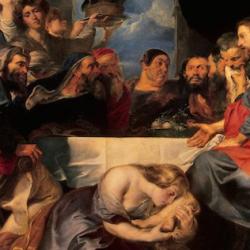As I’ve suggested in several recent posts, the turning point of Luke’s crucifixion narrative is the “conversion” of the criminal on the cross, and Jesus’ acceptance of Him into His kingdom. Jews and Romans had joined in mockery of Jesus’ claims to be “savior” and “king,” but the criminal entrusts himself to Jesus for his salvation and Jesus promises to bring him into His “kingdom,” His royal “Paradise.”
In Luke’s account, this exchange is immediately followed by a description of the darkening of the sky, the eclipse of the sun, and the rending of the temple veil. Within Luke 23, these events surrounding the crucifixion are structurally parallel to Jesus’ warning to the women about the coming destruction of the city, and thus have an “apocalyptic” character to them; darkness and the rending of the veil are proleptic signs of the coming destruction. And these occur after Jesus has accepted the criminal into His kingdom.
How are we to understand this sequence? Here are some possibilities: 1) Jesus’ acceptance of the criminal foreshadows the open acceptance of Gentiles and other “outcasts” into the church, and that is a prelude to the destruction of the temple. 2) When Jesus accepts the criminal, the temple is somehow rendered redundant or unusable. 3) Jesus’ acceptance of the criminal is a sign against the Jews, who have refused to accept the outcasts that Jesus has been dining with throughout His life. Thus, it is followed by signs of the doom of Israel. 4) Jesus’ acceptance of the criminal is a kind of “provocation to jealousy” of the Jews and Romans.
I’m sure there are other, more plausible explanations.















